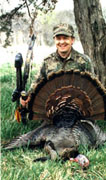Afternoon Hunting
Copyright © 1998 - 2021 Roger
W. Raisch * Nadine Adele, all rights reserved
|
Afternoon hunting
gives you a chance to try for gobblers that were abandoned by hens at midday and are
looking for company. But, before you do this, make certain
afternoon hunting is legal in your state. If it's not, you can still scout in the
afternoon to locate turkeys for the next morning and to learn about their habits and
behavior. Regardless, don't do this until after your nap!
|
Afternoon is
normally a time for feeding and rest. There will be
much less gobbling, but a tom that can be convinced to gobble will be very likely to come
to your call, especially if it's mid afternoon or after.
|
During the afternoon
feeding period, you are likely to see turkeys around timber edges, in pastures or in other
open feeding areas that are relatively close to good roosting areas. These locations
may very well be the same Strut
Zones that you identified for morning hunting.
|
Stalk into your
calling location quietly and slowly because turkeys may be close by. You may want to
start your calling with a Cackle to imitate a hen as she leaves her nest or flies across
an obstacle. A gobbler knows what that means...(a hen
is on the move) and may answer with a gobble. Unless a gobbler is actively gobbling
in response to your calling, you should call sparingly.
|
The afternoon gobbler will
normally come to you silently.
For this reason you may want to call only every 10 to 15 minutes and remain very alert for
a bird to appear out of nowhere.
Between calls you can Cluck a time or two to see if a gobbler will respond with a Cluck, Gobble or Drumming sound. Use the same calls you tried in the morning, namely Clucks and Purrs, snappy Yelps, an occasional Mating Cackle and Cutts.
Mix in plenty of low
volume Feeding Calls (Clucks, Purrs, Soft Yelps). If you are lucky and a bird begins to gobble regularly, work him
just like you would in the morning but don't expect him to come in very fast.
|
An afternoon hunt is
very much a wait and see type of hunt. If you are near
a good roosting site you may unknowingly call a gobbler close to your set up and he may
roost near the "hen". If your afternoon hunt is unsuccessful, you will
already be properly positioned to try to make a roosted gobbler sound off at sundown.
|
Another afternoon tactic
is to walk through the woods stopping occasionally to call in the hopes of getting a
gobbler to respond. This can work well especially if you know where gobblers are
likely to be. If nothing else happens you will have had a recent scouting trip in
that area and will have learned a bit more about turkeys. |
| |
t

God Bless America
|
View
Cart & Check-Out
NOVEMBER
2025
877.267.3877
515.299.5388
24 / 7
WE answer
our
phones Personally!
|
|












